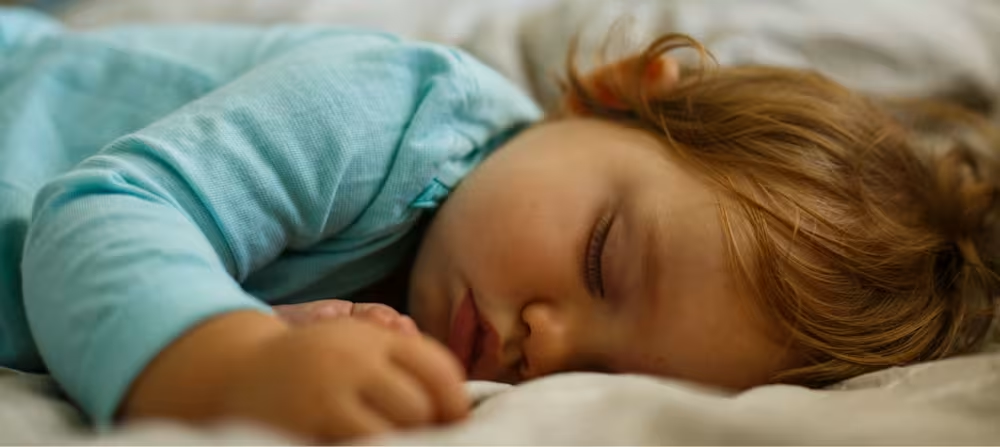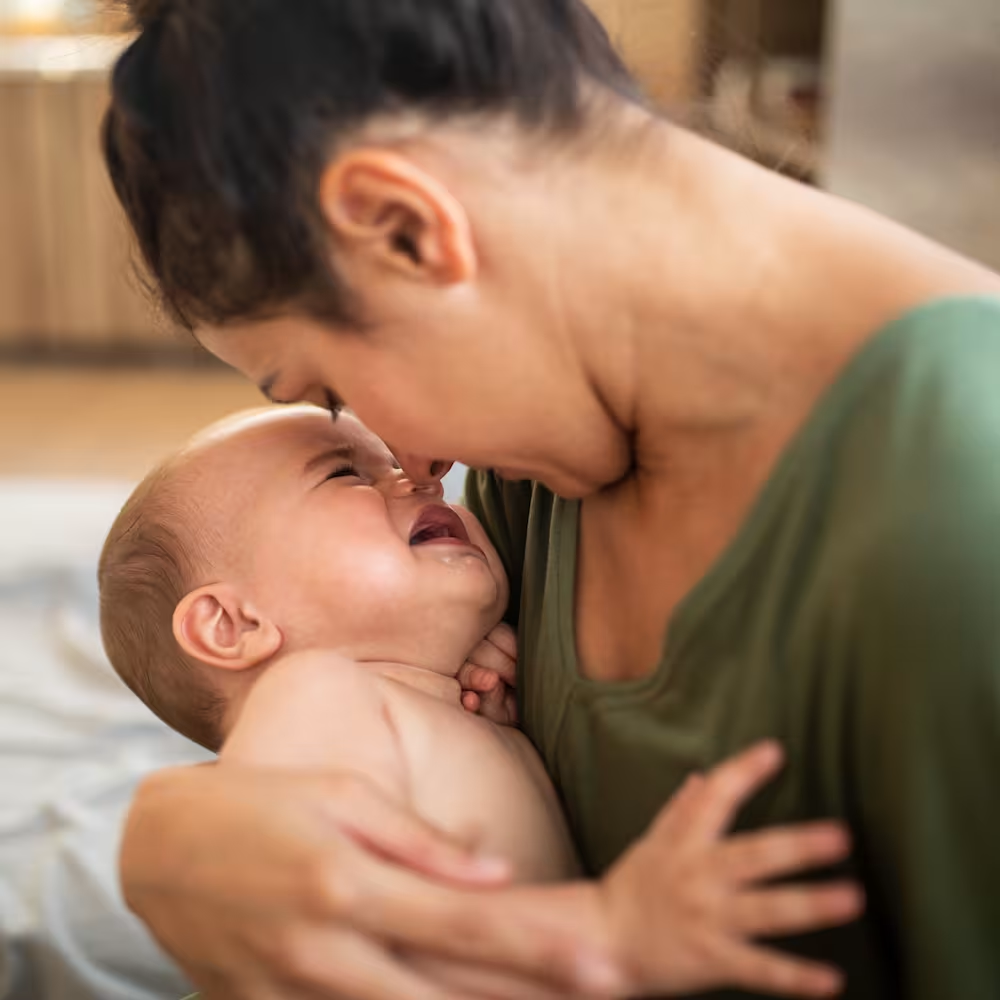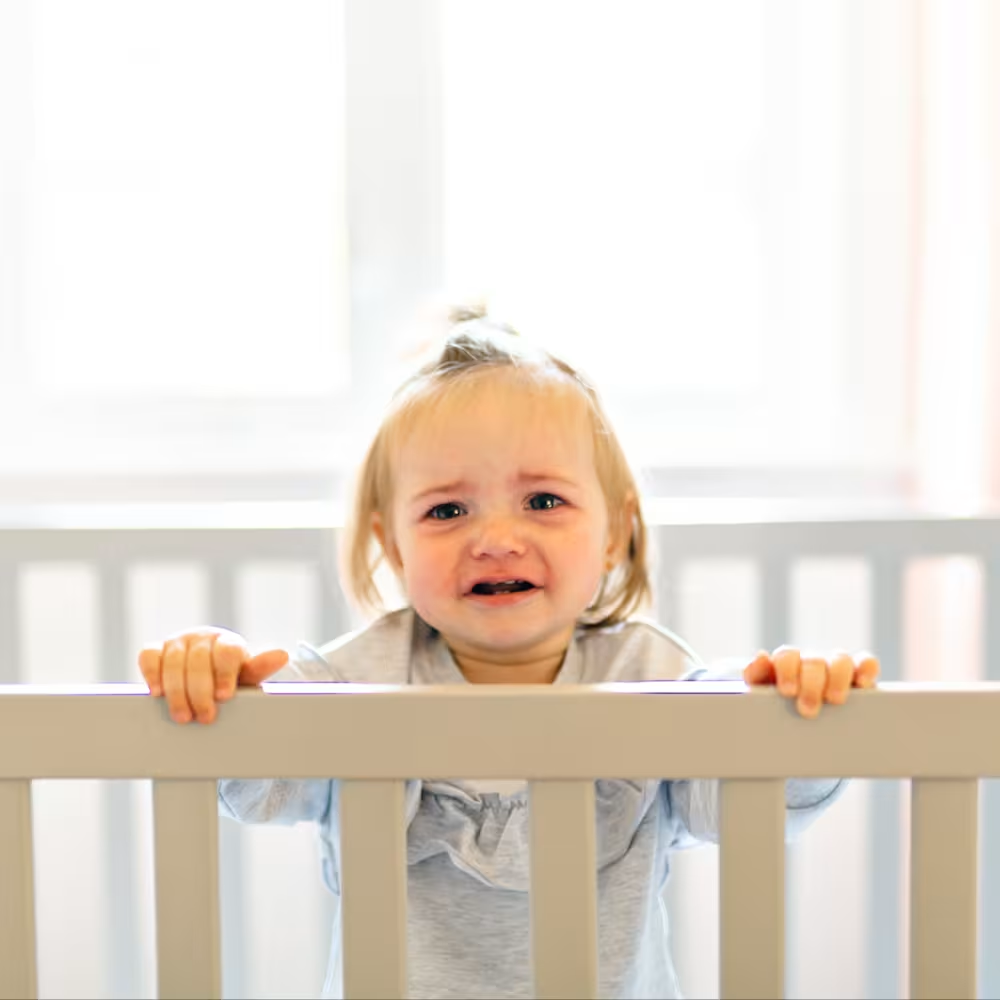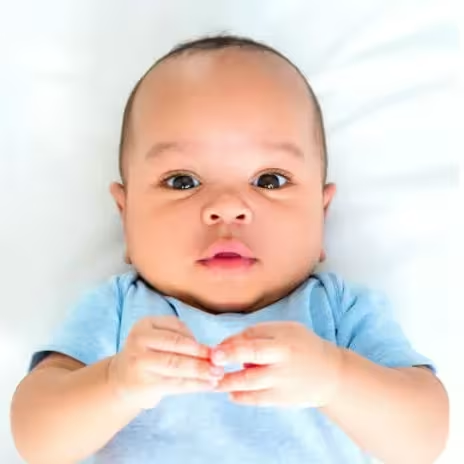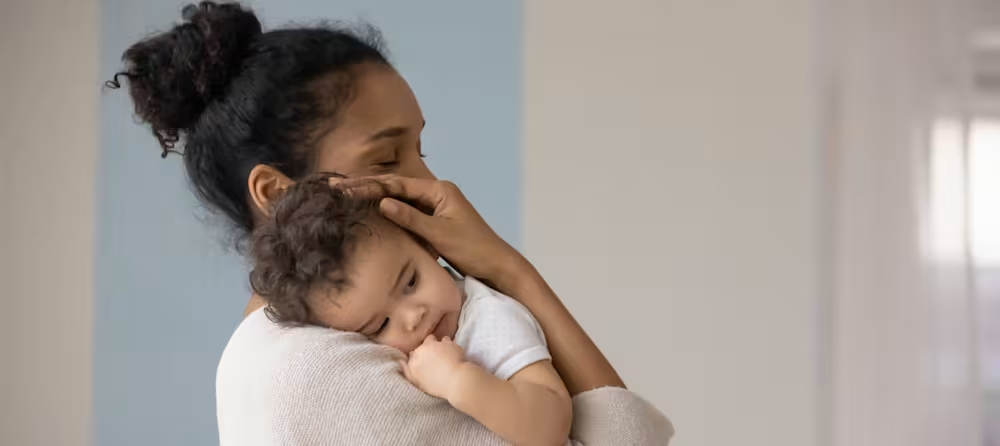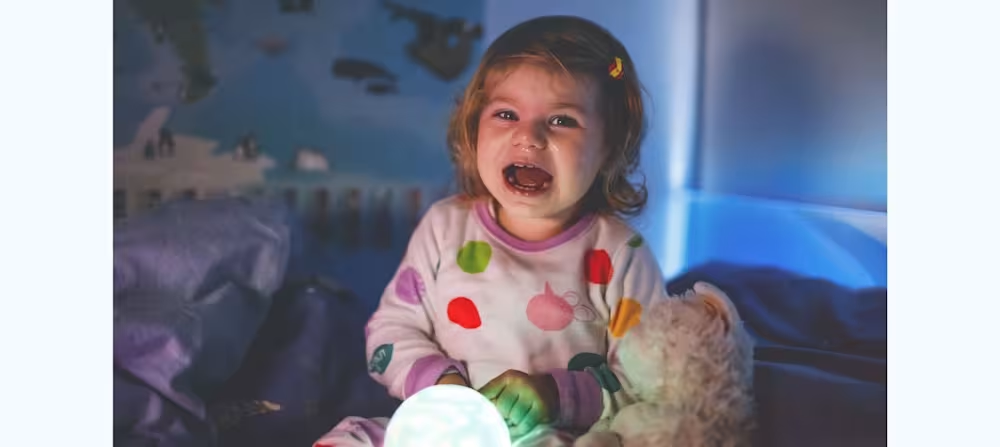When can babies sleep with a stuffed animal?
Updated Oct 16, 2025
Up-to-date
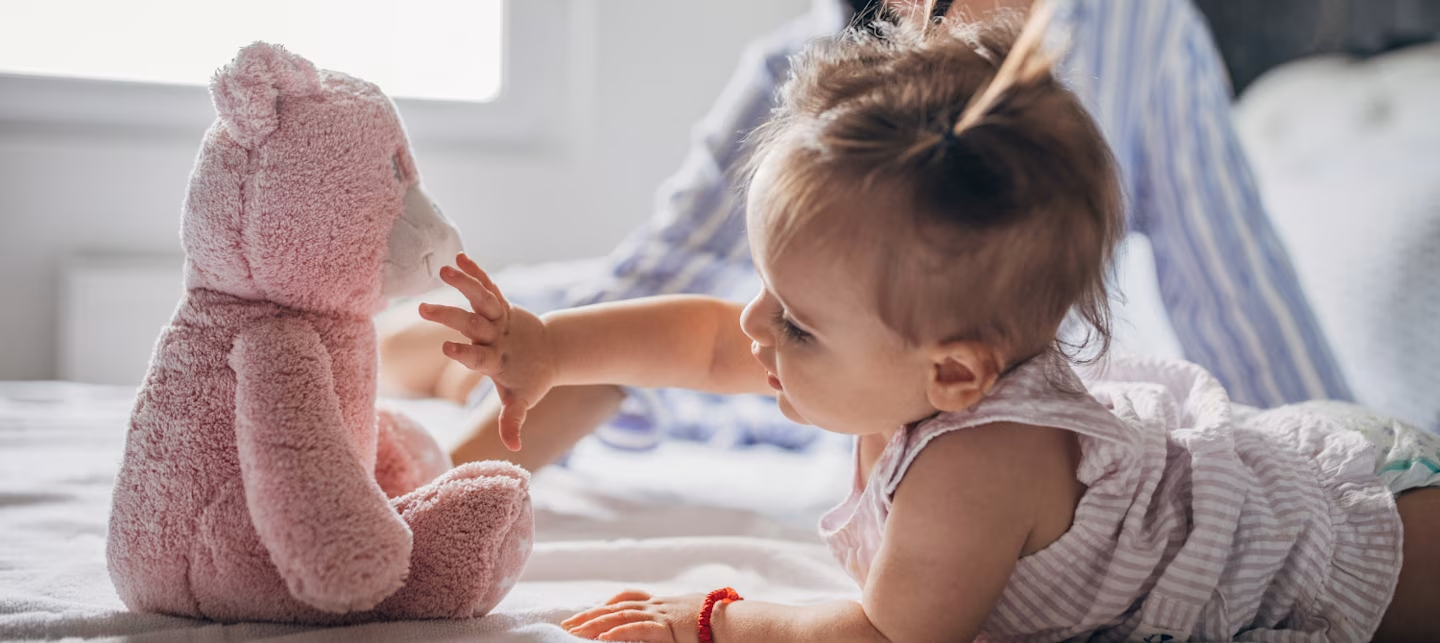
Few things are cuter than seeing your baby snuggled up with a stuffed animal. But hold that heart-melting moment of tucking your sleepy little one in with their favorite plushy until it’s safe! When it comes to safe sleep, waiting until the timing is right is everything (sorry, teddy) []. In this guide, we’ll cover when babies can safely have stuffed animals in the crib, safety tips to watch out for, and how to keep your kiddo cozy and protected overnight.
Table of Contents
Why caregivers want to introduce stuffed animals
It’s no mystery why stuffed animals are bedtime favorites for kids. They’re soft, cute, and frequently become like beloved family members. Here are a few reasons why you might be eager to tuck one into your child’s crib:
Emotional comfort: A familiar stuffed animal can help soothe children, especially at bedtime or during overnight wakeups [].
Bonding: Children often form early attachments to soft toys, which can become comforting companions as they grow [].
Transition support: Whether your little one is starting daycare, moving to a new sleep space, or dealing with separation anxiety, a stuffed animal can offer emotional comfort [].
Bedtime routine helper: Including a favorite soft toy in the can help signal that it’s time to wind down and sleep. Babies find comfort in rituals, and sometimes that involves a fuzzy sidekick!
At what age can a baby sleep with a stuffed animal?
According to the American Academy of Pediatrics (AAP), babies should not sleep with any soft objects — including stuffed animals, pillows, and blankets — until they’re at least 12 months old []. This recommendation helps reduce the risk of Sudden Infant Death Syndrome (SIDS) and suffocation. Even after 1 year, it’s important to choose toys carefully and follow safe sleep guidelines.
While that favorite stuffed animal may seem like a cozy addition, wait until it’s truly safe.
Here’s a quick breakdown by age:
Age | Stuffed animal in crib? | Notes |
0 - 6 months | No | Due to the risk of SIDS, your baby’s crib should be completely empty []. |
6 - 12 months | No | Stuffies can be introduced as part of your baby’s bedtime routine before sleep, but shouldn’t be left in their crib or sleep space just yet overnight or during naps unless (unless your pediatrician gives the OK). |
12 - 18 months | Yes, with caution | Choose soft, small, breathable toys without loose parts, accessories, or batteries. |
18+ months | Safe for most children | Safe stuffies can remain in your baby’s sleep space at night and during naps. |
2 - 5 years | Common and comforting | Soft plushies can be safely snuggled in toddler beds or sleep spaces with fewer restrictions. |
Are stuffed animals safe for babies under 1?
While stuffed animals can be perfectly safe during supervised play time or tummy time when awake, the AAP recommends keeping them out of your baby’s sleep space for if your little one is under 12 months old. Here’s why:
Suffocation risk: Even soft, plush toys can block a baby’s airway if they roll into one during sleep [].
Increased risk of SIDS: Keep the crib free of all soft objects (including stuffed animals) during your baby’s first year to help reduce the risk of SIDS [].
Limited mobility: Younger babies can’t always reliably move their heads or reposition themselves if something covers their nose or mouth [].
When can babies have toys or comfort items in the crib?
While cribs are designed for safe sleep, many caregivers wonder when adding toys or comfort items is OK. The short answer? It depends on your baby’s age, development, and whether they’re sleeping or just hanging out. Here's what to consider before adding anything extra to the crib.
Sleep time (naps and overnight)
For babies under 12 months, the AAP recommends keeping the crib completely clear of stuffed animals, pillows, blankets, or toys []. This keeps the sleep environment as safe as possible and reduces the risk of SIDS and suffocation. That said, some pediatricians will give clearance for younger babies to use a small lovey, depending on their health and development. Always check with your medical provider, as they’ll be able to make recommendations based on your individual child.
How to safely introduce a stuffed animal for sleep
What does nighttime stuffy readiness usually look like? A good measuring stick is that your baby has motor skills like being able to roll both ways, , move objects away from their face, and reposition themselves during sleep — abilities that can reduce the risk of suffocation. While each child is unique, these specific milestones tend to develop between 6 - 12 months []. However, even if your baby is showing early signs of readiness, that still doesn’t mean introducing a transitional object during sleep times is safe. Check with your medical provider for specific recommendations for your individual child. The AAP recommends waiting until your child is at least 12 months old to include stuffed animals in a child’s sleep space to reduce safety risks [].
That said, you don’t have to wait until your baby is 12 months old to encourage building a bond with a lovey. You can begin incorporating a stuffed animal into their wind-down routine at bedtime much earlier. And keep in mind that not every kiddo bonds with a stuffed animal. Some prefer a special blanket, beloved toy, or nothing at all — and that’s OK!
Here are some tips to make the transition to including stuffed animals at bedtime safe and fun.
Start slow and supervised: First, notice which stuffed animals, loveys, or toys your child seems to bond with during daytime play or supervised naps.
Have a backup: It’s a good idea to keep a backup lovey handy once your child develops an attachment, just in case the original is lost or damaged.
Time it right: Wait until after your baby’s first birthday (or until your child’s medical provider has given clearance) before introducing it in the crib.
Keep stuffies simple: Stick to one soft, breathable comfort object. Avoid anything oversized or with removable parts, and skip the toy pile. Less in the crib is more when it comes to safe sleep! []
What to look for in a safe stuffed animal
Not all stuffed animals are created equal, especially when it comes to sleep. If you’re adding a plushy to your baby’s crib, here’s what to keep in mind:
Soft and breathable: Look for plush toys made of lightweight, breathable fabrics to reduce the risk of overheating or suffocation.
No loose parts: Skip anything with buttons, plastic eyes, sequins, or accessories that could come off and become a choking hazard [].
Small in size: Make sure the toy is small enough that it won’t accidentally cover your baby’s face while they sleep, but big enough that it won’t be a choking hazard.
Hypoallergenic and washable: Most babies drool — a lot. Choose a toy that’s machine-washable and made from materials that won’t irritate sensitive skin [].
No batteries, sound boxes, or extras: As captivating as a talking teddy might be to your baby (and likely only your baby!), toys with batteries, wires, or removable parts don’t belong in the crib [].
When in doubt, simpler is safer. A classic, cuddly, no-frills stuffed animal is the gold standard for bedtime.
When do babies start liking stuffed animals?
Many babies show noticeable interest in stuffed animals as early as 8 - 12 months []. You might notice your little one reaching for a soft toy, exploring its texture, or lighting up when they see a familiar furry friend. Around this age, babies begin to form attachments to comfort objects, which is expected and even developmentally helpful.
But here’s the catch: While your baby might show signs of early bonding to a stuffy, that doesn’t mean it’s safe to include it during sleep just yet. It’s perfectly fine (and even helpful!) to incorporate a comfort item or lovey in your baby’s bedtime routine while they are still awake. Just be sure to remove it from the crib before sleep until your child is over 12 months old or your pediatrician gives the go-ahead.
Takeaway
Add a lovey to baby’s bedtime routine: You can include a stuffed animal in your baby’s wind-down routine before sleep to help build familiarity and comfort, but hold off on leaving it in the crib overnight or during naptime until your baby is 12 months old or your pediatrician gives the OK.
Watch for signs of readiness: Once your baby can roll, sit up, and move freely in sleep, they’re likely developmentally able to sleep alongside a comfort object — just make sure it’s safe.
Stick to one small, soft toy: Choose a breathable, washable stuffed animal with no loose parts, batteries, or removable accessories.
Stuffed animals and baby sleep FAQ
Share article:
Note: The content on this site is for informational purposes only and should not replace medical advice from your doctor, pediatrician, or medical professional. If you have questions or concerns, you should contact a medical professional.
11 Sources
Table of Contents
Share article:
